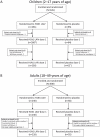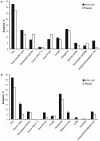Safety and immunogenicity following administration of a live, attenuated monovalent 2009 H1N1 influenza vaccine to children and adults in two randomized controlled trials
- PMID: 21060780
- PMCID: PMC2966412
- DOI: 10.1371/journal.pone.0013755
Safety and immunogenicity following administration of a live, attenuated monovalent 2009 H1N1 influenza vaccine to children and adults in two randomized controlled trials
Abstract
Background: The safety, tolerability, and immunogenicity of a monovalent intranasal 2009 A/H1N1 live attenuated influenza vaccine (LAIV) were evaluated in children and adults.
Methods/principal findings: Two randomized, double-blind, placebo-controlled studies were completed in children (2-17 y) and adults (18-49 y). Subjects were assigned 4:1 to receive 2 doses of H1N1 LAIV or placebo 28 days apart. The primary safety endpoint was fever ≥38.3°C during days 1-8 after the first dose; the primary immunogenicity endpoint was the proportion of subjects experiencing a postdose seroresponse. Solicited symptoms and adverse events were recorded for 14 days after each dose and safety data were collected for 180 days post-final dose. In total, 326 children (H1N1 LAIV, n = 261; placebo, n = 65) and 300 adults (H1N1 LAIV, n = 240; placebo, n = 60) were enrolled. After dose 1, fever ≥38.3°C occurred in 4 (1.5%) pediatric vaccine recipients and 1 (1.5%) placebo recipient (rate difference, 0%; 95% CI: -6.4%, 3.1%). No adults experienced fever following dose 1. Seroresponse rates in children (H1N1 LAIV vs. placebo) were 11.1% vs. 6.3% after dose 1 (rate difference, 4.8%; 95% CI: -9.6%, 13.8%) and 32.0% vs. 14.5% after dose 2 (rate difference, 17.5%; 95% CI: 5.5%, 27.1%). Seroresponse rates in adults were 6.1% vs. 0% (rate difference, 6.1%; 95% CI: -5.6%, 12.6%) and 14.9% vs. 5.6% (rate difference, 9.3%; 95% CI: -0.8%, 16.3%) after dose 1 and dose 2, respectively. Solicited symptoms after dose 1 (H1N1 LAIV vs. placebo) occurred in 37.5% vs. 32.3% of children and 41.7% vs. 31.7% of adults. Solicited symptoms occurred less frequently after dose 2 in adults and children. No vaccine-related serious adverse events occurred.
Conclusions/significance: In subjects aged 2 to 49 years, two doses of H1N1 LAIV have a safety and immunogenicity profile similar to other previously studied and efficacious formulations of seasonal trivalent LAIV.
Trial registration: ClinicalTrials.gov NCT00946101, NCT00945893.
Conflict of interest statement
Figures



Similar articles
-
A study to evaluate the immunogenicity and shedding of live attenuated influenza vaccine strains in children 24-<48 months of age.Vaccine. 2020 Jan 29;38(5):1001-1008. doi: 10.1016/j.vaccine.2019.11.055. Epub 2019 Nov 30. Vaccine. 2020. PMID: 31796225 Clinical Trial.
-
Safety and immunogenicity of a live attenuated influenza H5 candidate vaccine strain A/17/turkey/Turkey/05/133 H5N2 and its priming effects for potential pre-pandemic use: a randomised, double-blind, placebo-controlled trial.Lancet Infect Dis. 2017 Aug;17(8):833-842. doi: 10.1016/S1473-3099(17)30240-2. Epub 2017 May 19. Lancet Infect Dis. 2017. PMID: 28533093 Free PMC article. Clinical Trial.
-
Immunogenicity and Viral Shedding of Russian-Backbone, Seasonal, Trivalent, Live, Attenuated Influenza Vaccine in a Phase II, Randomized, Placebo-Controlled Trial Among Preschool-Aged Children in Urban Bangladesh.Clin Infect Dis. 2019 Aug 16;69(5):777-785. doi: 10.1093/cid/ciy1003. Clin Infect Dis. 2019. PMID: 30481272 Free PMC article. Clinical Trial.
-
Live attenuated influenza vaccine (FluMist®; Fluenz™): a review of its use in the prevention of seasonal influenza in children and adults.Drugs. 2011 Aug 20;71(12):1591-622. doi: 10.2165/11206860-000000000-00000. Drugs. 2011. PMID: 21861544 Review.
-
Live attenuated intranasal influenza vaccine.Hum Vaccin Immunother. 2012 Jan;8(1):76-80. doi: 10.4161/hv.8.1.18809. Epub 2012 Jan 1. Hum Vaccin Immunother. 2012. PMID: 22251995 Review.
Cited by
-
Noninvasive vaccination against infectious diseases.Hum Vaccin Immunother. 2018 Jul 3;14(7):1717-1733. doi: 10.1080/21645515.2018.1461296. Epub 2018 May 17. Hum Vaccin Immunother. 2018. PMID: 29624470 Free PMC article. Review.
-
Mucosal targeting of a BoNT/A subunit vaccine adjuvanted with a mast cell activator enhances induction of BoNT/A neutralizing antibodies in rabbits.PLoS One. 2011 Jan 27;6(1):e16532. doi: 10.1371/journal.pone.0016532. PLoS One. 2011. PMID: 21304600 Free PMC article.
-
Decreased serologic response in vaccinated military recruits during 2011 correspond to genetic drift in concurrent circulating pandemic A/H1N1 viruses.PLoS One. 2012;7(4):e34581. doi: 10.1371/journal.pone.0034581. Epub 2012 Apr 13. PLoS One. 2012. PMID: 22514639 Free PMC article.
-
Vaccines for preventing influenza in healthy children.Cochrane Database Syst Rev. 2012 Aug 15;2012(8):CD004879. doi: 10.1002/14651858.CD004879.pub4. Cochrane Database Syst Rev. 2012. Update in: Cochrane Database Syst Rev. 2018 Feb 01;2:CD004879. doi: 10.1002/14651858.CD004879.pub5. PMID: 22895945 Free PMC article. Updated.
-
Recommendations on the use of live, attenuated influenza vaccine (FluMist®): Supplemental Statement on Seasonal Influenza Vaccine for 2011-2012 An Advisory Committee Statement (ACS) National Advisory Committee on Immunization (NACI)†.Can Commun Dis Rep. 2011 Nov 30;37(ACS-7):1-77. doi: 10.14745/ccdr.v37i00a07. eCollection 2011 Nov 30. Can Commun Dis Rep. 2011. PMID: 31682654 Free PMC article. No abstract available.
References
-
- Maassab HF. Biologic and immunologic characteristics of cold-adapted influenza virus. J Immunol. 1969;102:728–732. - PubMed
-
- Jin H, Lu B, Zhou H, Ma C, Zhao J, et al. Multiple amino acid residues confer temperature sensitivity to human influenza virus vaccine strains (FluMist) derived from cold-adapted A/Ann Arbor/6/60. Virology. 2003;306:18–24. - PubMed
-
- Belshe R, Lee MS, Walker RE, Stoddard J, Mendelman PM. Safety, immunogenicity and efficacy of intranasal, live attenuated influenza vaccine. Expert Rev Vaccines. 2004;3:643–654. - PubMed
-
- Englund JA, Walter EB, Fairchok MP, Monto AS, Neuzil KM. A comparison of 2 influenza vaccine schedules in 6- to 23-month-old children. Pediatrics. 2005;115:1039–1047. - PubMed
-
- Neuzil KM, Jackson LA, Nelson J, Klimov A, Cox N, et al. Immunogenicity and reactogenicity of 1 versus 2 doses of trivalent inactivated influenza vaccine in vaccine-naive 5-8-year-old children. J Infect Dis. 2006;194:1032–1039. - PubMed
Publication types
MeSH terms
Substances
Associated data
LinkOut - more resources
Full Text Sources
Medical

